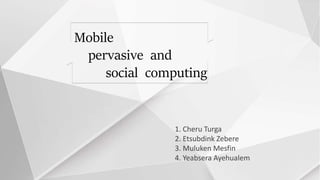
Presentation1.pptx
- 1. 1. Cheru Turga 2. Etsubdink Zebere 3. Muluken Mesfin 4. Yeabsera Ayehualem Mobile pervasive and social computing
- 2. Outline What is moblie computing use of mobile computing charactersitcs of mobile computing What is pervasive computing use of pervasive computing charactersitcs of pervasivecomputing What is social computing use of social computing charactersitcs of socialcomputing
- 3. Mobile computing Mobile computing: Mobile computing refers to the use of portable computing devices such as smartphones, tablets, or laptops, to perform a variety of tasks and access information while on the move. It involves the use of wireless networks and mobile communication technologies to provide ubiquitous connectivity and access to digital resources, enabling users to complete work, browse the internet, communicate with others, or engage in entertainment activities from virtually anywhere.
- 4. Mobile computing The concept of Mobile Computing can be divided into three parts: 1. Mobile Communication:
- 5. Mobile computing 2. Mobile Hardware:
- 6. Mobile computing 3. Mobile Software:
- 7. Mobile computing Functionality or use of mobile computing: Communication Internet access Entertainment Productivity Location-based services Mobile payments Health and fitness
- 8. Mobile computing CHARACTERISTICS OF MOBILE COMPUTING: Portability Social Interactivity Context Sensitivity Connectivity Individual Small Size Wireless Communication
- 9. Pervasive computing Pervasive computing: • Pervasive computing, also called ubiquitous computing, is the growing trend of embedding computational capability (generally in the form of microprocessors) into everyday objects to make them effectively communicate and perform useful tasks in a way that minimizes the end user's need to interact with computers as computers. Pervasive computing devices are network-connected and constantly available. • Unlike desktop computing, pervasive computing can occur with any device, at any time, in any place and in any data format across any network and can hand tasks from one computer to another .
- 10. Pervasive computing Functionality or use of pervasive computing: Data collection and analysis Real-time feedback Context-awareness Location awareness Automation and control
- 11. Pervasive computing Characterstics of pervasive computing: Ubiquity Context Awareness Heterogeneity Transparency Proactivity Independence
- 12. Social computing Social computing: • Social computing is a broad concept that encompasses the use of computer technologies to enable social interaction, communication, and collaboration among individuals and groups. It involves the creation, sharing, and consumption of user-generated content in online communities or social networks, as well as the use of various tools and platforms to facilitate social interaction and collaboration. • Examples of social computing platforms include social media, messaging apps, blogs, wikis, online forums, and virtual worlds, among others.
- 13. Social computing Functionality of social computing: Social Networking Online Communities User-Generated Content Communication and Collaboration Social Media Mobile Computing Artificial Intelligence
- 14. Social computing Characteristics of social computing: User-Driven and User-Generated Community-Oriented Collaboration and Sharing Real-Time Interactions User-Centric Personalized and Customizable Scalable
- 15. THANKS